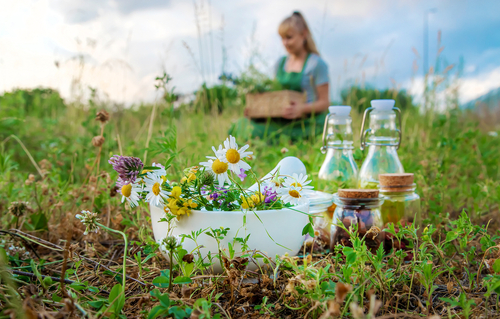Rooted in Rhythm
Women’s bodies are deeply rhythmic—woven into the moon, the tides, the turning of the seasons. The menstrual cycle, fertility, pregnancy, menopause—all are natural transitions, not problems to be fixed, but phases to be supported with understanding, rest, and nourishment.
In traditional medicine, herbs were trusted companions throughout a woman’s life. Passed down through generations, these plants offered balance during hormonal shifts, relief in times of discomfort, and gentle support for cycles both monthly and lifelong. Today, with so many external pressures and internal imbalances, reconnecting with this plant wisdom can be a powerful way to reclaim one’s health—naturally, gently, and with care.
Ad Spot #1
(Insert your first promotional element here.)
Listening to the Body
Hormones are messengers—subtle, powerful, and deeply sensitive to change. They respond not only to internal cues, but to stress, sleep, diet, and emotional state. When imbalance occurs, the signs are often clear: irregular cycles, mood swings, fatigue, painful periods, or symptoms of perimenopause.
Rather than silencing these messages, herbal remedies can help the body recalibrate. Certain plants are known for their ability to support hormonal harmony, gently nudging systems back into balance and offering steady, nourishing support.
Trusted Herbal Allies for Hormonal Balance
Vitex (Chaste Tree Berry)
Vitex is one of the most widely used herbs for supporting the menstrual cycle and reproductive health. It works through the pituitary gland, gently encouraging balanced production of progesterone. Particularly helpful for irregular cycles, PMS, and symptoms of perimenopause, vitex acts slowly over time—its effects becoming more noticeable after consistent use.
Often taken as a tincture or capsule first thing in the morning, vitex is best used as a long-term tonic rather than a quick remedy.
Red Raspberry Leaf
A classic uterine tonic, red raspberry leaf strengthens and tones the reproductive system. It’s particularly supportive in the second half of the cycle, during pregnancy, and even postpartum. High in minerals like magnesium and iron, it helps nourish depleted systems and ease cramping or heavy bleeding.
Prepared as a daily infusion, it blends beautifully with herbs like nettle, oatstraw, or lemon balm for added support.
Maca Root
A hardy root from the high Andes, maca is classified as an adaptogen—helping the body manage stress and regulate hormone production. While not directly estrogenic, maca supports the endocrine system as a whole, which in turn may improve energy, libido, and mood throughout the cycle.
Maca powder can be blended into warm drinks or taken in capsules. It tends to be more stimulating, so morning use is often best.
Dong Quai
Often called “female ginseng,” dong quai is traditionally used to support blood flow and relieve stagnation in the reproductive system. It may be helpful for those experiencing menstrual irregularity, scant flow, or stagnation-related discomfort like cramping and tension.
Because it stimulates circulation, it’s typically avoided during menstruation itself or pregnancy, but used in the earlier parts of the cycle.
Lemon Balm and Oatstraw
While not specifically hormonal, these gentle nervines support the nervous system, which plays a vital role in hormone regulation. Lemon balm can lift the mood and calm anxious energy, while oatstraw nourishes and soothes when stress has left the system frayed or depleted.
Together, they make a lovely base for daily teas and tonics.
Herbal Teas and Tonics for Daily Balance
One of the simplest ways to work with herbs is through daily infusions. These teas can be blended at home and sipped throughout the day, offering both hydration and steady herbal nourishment.
Cycle Support Tea
Ingredients:
-
1 part red raspberry leaf
-
1 part lemon balm
-
1 part oatstraw
-
½ part nettle
-
Optional: dried rose petals for heart-softening support
Instructions:
-
Mix dried herbs and store in a sealed jar.
-
Use 1–2 tablespoons per quart of boiling water.
-
Steep for 4–8 hours (or overnight), strain, and sip throughout the day.
Drink during the follicular and luteal phases (before and after ovulation) to help support overall cycle health and reduce tension.
Hormone Harmony Tincture (Simple Blend)
Ingredients:
-
Vitex tincture (30 drops)
-
Maca tincture (20 drops)
-
Add to a splash of water or herbal tea once daily in the morning.
This combination offers endocrine support and may help regulate cycles over time. Use consistently for several months for best results.
Ad Spot #2
(Insert your second promotional element here.)
A Gentle Word of Care
Though herbs are gentle, they are still powerful and should be approached with care—especially when it comes to the intricate dance of hormones. Each body is different, and what brings balance to one may not be right for another.
It’s wise to begin slowly, listen closely, and track your cycle, mood, and energy as you work with herbs. Give your body time to respond, and seek guidance from a trusted herbalist or practitioner if unsure. Avoid combining too many hormonal herbs at once, and be mindful when using herbs like dong quai or maca if pregnant or managing specific conditions.
Let your approach be rooted in respect. Herbs are not quick fixes—they are companions on the path of deeper balance.
In Tune with the Seasons Within
Tending to hormonal health with herbs is about more than symptom relief. It’s about honoring the body’s changes, creating space for rest, and finding rhythm in the midst of life’s constant movement. Whether you are navigating your first cycles, preparing for conception, balancing postpartum life, or easing into menopause—there are herbs to walk beside you.
They remind us that wellness isn’t static—it flows. And the more we align with that flow, the more ease we find.
From the root to the flower, these plants offer their wisdom. And in listening, we begin to remember our own.



























